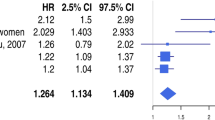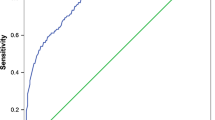Abstract
It remains uncertain whether plasma D-dimer level can predict no-reflow in patients with STEMI who had pPCI after 48 h of symptom onset. This study retrospectively enrolled 229 consecutive patients who had pPCI for acute STEMI within 2–7 days of symptom onset between January 2008 and December 2018. Patients were divided into no-reflow group (TIMI flow grade 0–2) and reflow group (TIMI flow grade 3). Predictors of no-reflow were assessed by univariate and multivariate binary logistic regression analyses. Plasma D-dimer level can independently predict no-reflow in patients with STEMI who had pPCI within 2–7 days of symptom onset (OR 2.52 per 1 mg/L increase, 95% CI 1.16–5.47, p = 0.019). This finding indicated that pPCI may be safe and feasible for STEMI patients within 2–7 days of symptom onset with low D-dimer level.

Plasma D-dimer level can independently predict no-reflow in patients with STEMI who had pPCI within 2–7 days of symptom onset. pPCI may be safe and feasible for STEMI patients within 2–7 days of symptom onset with low D-dimer level.


Similar content being viewed by others
Abbreviations
- cTnT:
-
Cardiac troponin T
- ECG:
-
Electrocardiogram
- eGFR:
-
Estimated glomerular filtration rate
- hs-CRP:
-
High-sensitivity C-reactive protein
- IRA:
-
Infarct-related artery
- MACE:
-
Major cardiovascular adverse events
- MI:
-
Myocardial infarction
- NT-pro BNP:
-
N-terminal pro-B-type natriuretic peptide
- pPCI:
-
Primary percutaneous coronary intervention
- PTCA:
-
Percutaneous transluminal coronary angioplasty
- STEMI:
-
ST-segment elevation myocardial infarction
- TIMI:
-
Thrombolysis in myocardial infarction
References
Ibanez, B., James, S., Agewall, S., et al. (2018). 2017 ESC guidelines for the management of acute myocardial infarction in patients presenting with ST-segment elevation: the task force for the management of acute myocardial infarction in patients presenting with ST-segment elevation of the European Society of Cardiology (esc). European Heart Journal, 39, 119–177.
Authors/Task Force m, Windecker, S., Kolh, P., et al. (2014). 2014 ESC/EACTS guidelines on myocardial revascularization: the task force on myocardial revascularization of the European Society of Cardiology (ESC) and the European Association for Cardio-Thoracic Surgery (EACTS) developed with the special contribution of the European Association of Percutaneous Cardiovascular Interventions (EAPCI). European Heart Journal, 35, 2541–2619.
Eagle, K. A., Goodman, S. G., Avezum, A., et al. (2002). Practice variation and missed opportunities for reperfusion in ST-segment-elevation myocardial infarction: findings from the Global Registry of Acute Coronary Events (GRACE). Lancet, 359, 373–377.
Hochman, J. S., Lamas, G. A., Buller, C. E., et al. (2006). Coronary intervention for persistent occlusion after myocardial infarction. The New England Journal of Medicine, 355, 2395–2407.
Celik, T., Balta, S., Demir, M., et al. (2016). Predictive value of admission red cell distribution width-platelet ratio for no-reflow phenomenon in acute ST segment elevation myocardial infarction undergoing primary percutaneous coronary intervention. Cardiology Journal, 23, 84–92.
Ndrepepa, G., Tiroch, K., Fusaro, M., et al. (2010). 5-year prognostic value of no-reflow phenomenon after percutaneous coronary intervention in patients with acute myocardial infarction. Journal of the American College of Cardiology, 55, 2383–2389.
Rezkalla, S. H., & Kloner, R. A. (2008). Coronary no-reflow phenomenon: from the experimental laboratory to the cardiac catheterization laboratory. Catheterization and Cardiovascular Interventions, 72, 950–957.
Napodano, M., Ramondo, A., Tarantini, G., et al. (2009). Predictors and time-related impact of distal embolization during primary angioplasty. European Heart Journal, 30, 305–313.
Izgi, A., Kirma, C., Tanalp, A. C., et al. (2007). Predictors and clinical significance of angiographically detected distal embolization after primary percutaneous coronary interventions. Coronary Artery Disease, 18, 443–449.
Mathew, V., & Gersh, B. J. (2004). To open or not to open: that remains the question. European Heart Journal, 25, 2177–2179.
Hou, H., Ge, Z., Ying, P., et al. (2012). Biomarkers of deep venous thrombosis. Journal of Thrombosis and Thrombolysis, 34, 335–346.
Erkol, A., Oduncu, V., Turan, B., et al. (2014). The value of plasma D-dimer level on admission in predicting no-reflow after primary percutaneous coronary intervention and long-term prognosis in patients with acute ST segment elevation myocardial infarction. Journal of Thrombosis and Thrombolysis, 38, 339–347.
Zhang, H., Qiu, B., Zhang, Y., et al. (2018). The value of pre-infarction angina and plasma D-dimer in predicting no-reflow after primary percutaneous coronary intervention in ST-segment elevation acute myocardial infarction patients. Medical Science Monitor, 24, 4528–4535.
Sarli, B., Akpek, M., Baktir, A. O., et al. (2015). Impact of D-dimer level on postinterventional coronary flow and in-hospital mace in ST-segment elevation myocardial infarction. Herz, 40, 507–513.
Alpert, J. S. (2018). The fourth edition of the universal definition of myocardial infarction. The American Journal of Medicine, 131, 1265–1266.
Gibson, C. M., Murphy, S. A., Rizzo, M. J., et al. (1999). Relationship between TIMI frame count and clinical outcomes after thrombolytic administration. Thrombolysis in myocardial infarction (TIMI) study group. Circulation, 99, 1945–1950.
Rezkalla, S. H., & Kloner, R. A. (2002). No-reflow phenomenon. Circulation, 105, 656–662.
Gibson, C. M., de Lemos, J. A., Murphy, S. A., et al. (2001). Combination therapy with abciximab reduces angiographically evident thrombus in acute myocardial infarction: a timi 14 substudy. Circulation, 103, 2550–2554.
Gottdiener, J. S., Bednarz, J., Devereux, R., et al. (2004). American society of echocardiography recommendations for use of echocardiography in clinical trials. Journal of the American Society of Echocardiography, 17, 1086–1119.
Horie, H., Takahashi, M., Minai, K., et al. (1998). Long-term beneficial effect of late reperfusion for acute anterior myocardial infarction with percutaneous transluminal coronary angioplasty. Circulation, 98, 2377–2382.
Steg, P. G., Thuaire, C., Himbert, D., et al. (2004). Decopi (desobstruction coronaire en post-infarctus): a randomized multi-centre trial of occluded artery angioplasty after acute myocardial infarction. European Heart Journal, 25, 2187–2194.
Hochman, J. S., Lamas, G. A., Knatterud, G. L., et al. (2005). Design and methodology of the occluded artery trial (OAT). American Heart Journal, 150, 627–642.
Ramjane, K., Han, L., & Jin, C. (2008). The diagnosis and treatment of the no-reflow phenomenon in patients with myocardial infarction undergoing percutaneous coronary intervention. Experimental and Clinical Cardiology, 13, 121–128.
Ardissino, D., Merlini, P. A., Bauer, K. A., et al. (2003). Coagulation activation and long-term outcome in acute coronary syndromes. Blood, 102, 2731–2735.
Silvain, J., Collet, J. P., Nagaswami, C., et al. (2011). Composition of coronary thrombus in acute myocardial infarction. Journal of the American College of Cardiology, 57, 1359–1367.
Limbruno, U., De Carlo, M., Pistolesi, S., et al. (2005). Distal embolization during primary angioplasty: histopathologic features and predictability. American Heart Journal, 150, 102–108.
Undas, A., Szuldrzynski, K., Stepien, E., et al. (2008). Reduced clot permeability and susceptibility to lysis in patients with acute coronary syndrome: effects of inflammation and oxidative stress. Atherosclerosis, 196, 551–557.
Becattini, C., Lignani, A., Masotti, L., Forte, M. B., & Agnelli, G. (2012). D-dimer for risk stratification in patients with acute pulmonary embolism. Journal of Thrombosis and Thrombolysis, 33, 48–57.
Hochuli, M., Duewell, S., & Frauchiger, B. (2007). Quantitative D-dimer levels and the extent of venous thromboembolism in CT angiography and lower limb ultrasonography. Vasa, 36, 267–274.
Jeebun, V., Doe, S. J., Singh, L., Worthy, S. A., & Forrest, I. A. (2010). Are clinical parameters and biomarkers predictive of severity of acute pulmonary emboli on CTPA? QJM, 103, 91–97.
Ghanima, W., Abdelnoor, M., Holmen, L. O., et al. (2007). D-dimer level is associated with the extent of pulmonary embolism. Thrombosis Research, 120, 281–288.
Kikkert, W. J., Claessen, B. E., Stone, G. W., et al. (2014). D-dimer levels predict ischemic and hemorrhagic outcomes after acute myocardial infarction: a horizons-ami biomarker substudy. Journal of Thrombosis and Thrombolysis, 37, 155–164.
Pengo, V., Palareti, G., Cosmi, B., et al. (2008). D-dimer testing and recurrent venous thromboembolism after unprovoked pulmonary embolism: a post-hoc analysis of the prolong extension study. Thrombosis and Haemostasis, 100, 718–721.
Verhovsek, M., Douketis, J. D., Yi, Q., et al. (2008). Systematic review: D-dimer to predict recurrent disease after stopping anticoagulant therapy for unprovoked venous thromboembolism. Annals of Internal Medicine, 149(481–490), W494.
Kearon, C., Spencer, F. A., O'Keeffe, D., et al. (2015). D-dimer testing to select patients with a first unprovoked venous thromboembolism who can stop anticoagulant therapy: a cohort study. Annals of Internal Medicine, 162, 27–34.
Palareti, G., Cosmi, B., Legnani, C., et al. (2006). D-dimer testing to determine the duration of anticoagulation therapy. The New England Journal of Medicine, 355, 1780–1789.
Kucher, N., Schroeder, V., & Kohler, H. P. (2003). Role of blood coagulation factor xiii in patients with acute pulmonary embolism. Correlation of factor xiii antigen levels with pulmonary occlusion rate, fibrinogen, D-dimer, and clot firmness. Thrombosis and Haemostasis, 90, 434–438.
Yip, H. K., Chen, M. C., Chang, H. W., et al. (2002). Angiographic morphologic features of infarct-related arteries and timely reperfusion in acute myocardial infarction: predictors of slow-flow and no-reflow phenomenon. Chest, 122, 1322–1332.
Yousef, Z. R., Redwood, S. R., Bucknall, C. A., Sulke, A. N., & Marber, M. S. (2002). Late intervention after anterior myocardial infarction: effects on left ventricular size, function, quality of life, and exercise tolerance: results of the open artery trial (toat study). Journal of the American College of Cardiology, 40, 869–876.
Dzavik, V., Buller, C. E., Lamas, G. A., et al. (2006). Randomized trial of percutaneous coronary intervention for subacute infarct-related coronary artery occlusion to achieve long-term patency and improve ventricular function: the total occlusion study of Canada (TOSCA)-2 trial. Circulation, 114, 2449–2457.
Acknowledgments
The authors would like to thank the research staff for their help.
Funding
This work was supported by the National Key Research and Development Program of China (2016YFC1301200) and the National Natural Science Foundation of China (81200170, 81870269, 81570223).
Author information
Authors and Affiliations
Corresponding authors
Ethics declarations
Conflict of Interest
The authors declare that they have no conflict of interest.
Human Subjects/Informed Consent Statement
No treatment was tested in patients by the authors for this article. Fudan University affiliated Zhongshan Hospital Ethics Committee had approved the work and received all the written informed consent.
Additional information
Associate Editor Craig M. Stolen oversaw the review of this article
Publisher’s Note
Springer Nature remains neutral with regard to jurisdictional claims in published maps and institutional affiliations.
Xue Gong and Xiaoting Lei are co-first authors.
Rights and permissions
About this article
Cite this article
Gong, X., Lei, X., Huang, Z. et al. D-Dimer Level Predicts Angiographic No-Reflow Phenomenon After Percutaneous Coronary Intervention Within 2–7 Days of Symptom Onset in Patients with ST-Segment Elevation Myocardial Infarction. J. of Cardiovasc. Trans. Res. 14, 728–734 (2021). https://doi.org/10.1007/s12265-020-09991-6
Received:
Accepted:
Published:
Issue Date:
DOI: https://doi.org/10.1007/s12265-020-09991-6




